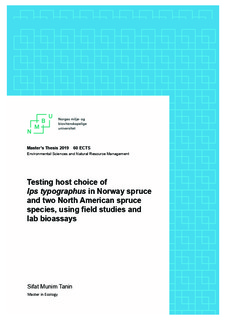| dc.contributor.advisor | Krokene, Paal | |
| dc.contributor.author | Tanin, Sifat Munim | |
| dc.date.accessioned | 2019-10-22T09:33:57Z | |
| dc.date.available | 2019-10-22T09:33:57Z | |
| dc.date.issued | 2019 | |
| dc.identifier.uri | http://hdl.handle.net/11250/2623665 | |
| dc.description.abstract | The spruce bark beetle Ips typographus is one of the most damaging pests in Europe’s boreal forests and cause catastrophic tree mortality during outbreaks. Norway spruce (Picea abies), an economically important forest tree, is the principal host for I. typographus. The beetle carries a number of fungal symbionts into the bark when they attack trees. These bluestain fungi help the beetles by metabolizing the tree’s defense chemicals. Ips typographus has been intercepted more than 200 times in US ports but has never become established in North America. To test if the beetle can find suitable host trees in North America, I compared the preference of I. typographus for its historical host Norway spruce and two common North American spruce species, black spruce (P. mariana) and white spruce (P. glauca). I observed no notable differences in beetle preference for the historical European host and the two North American spruce species when the beetles were allowed to colonize cut spruce bolts in the field. The beetles also produced abundant offspring in all three spruce species. Different fungi, either accompanied by Ips typographus or the North American spruce beetle Dendroctonus rufipennis, were used to study the fungi’s influence on beetle host choice. In lab bioassays with semi-natural spruce bark media I. typographus showed a clear preference for media colonized by fungi. This preference did not depend on whether the fungi were European or North American. In the absence of fungus, the beetles readily tunneled into medium from Norway spruce, black spruce or white spruce bark. Bluestain fungi emit volatile organic compounds and further bioassays demonstrated that I. typographus could select specific fungi using smell. In conclusion, I. typographus readily colonizes and produce offspring in North American spruce species, and fungal colonization increases beetle tunneling into spruce bark media. These results suggest that the beetle will be able to find suitable host trees if it should become established in North America. | nb_NO |
| dc.language.iso | eng | nb_NO |
| dc.publisher | Norwegian University of Life Sciences, Ås | nb_NO |
| dc.rights | Attribution-NonCommercial-NoDerivatives 4.0 Internasjonal | * |
| dc.rights.uri | http://creativecommons.org/licenses/by-nc-nd/4.0/deed.no | * |
| dc.subject | Spruce | nb_NO |
| dc.subject | Beetles | nb_NO |
| dc.subject | North America | nb_NO |
| dc.subject | Europe | nb_NO |
| dc.title | Testing host choice of Ips typographus in Norway spruce and two North American spruce species, using field studies and lab analysis | nb_NO |
| dc.type | Master thesis | nb_NO |
| dc.description.localcode | M-ECOL | nb_NO |

